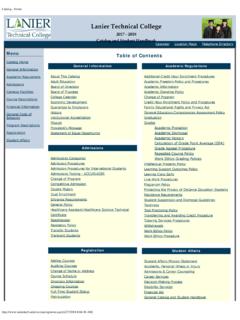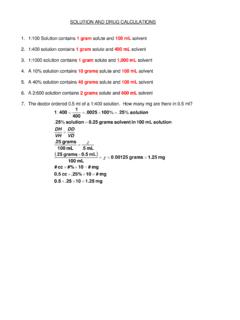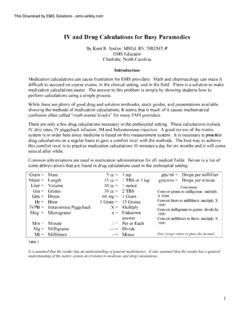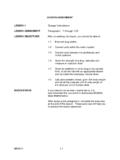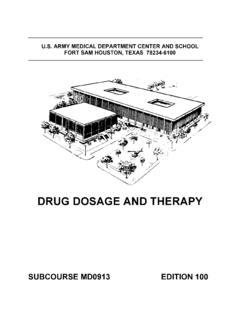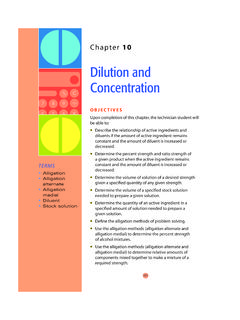Transcription of Fundamentals of Mathematics for Nursing
1 Fundamentals of Mathematics for Nursing Cynthia M. McAlister Sandra G. Shapiro ARNP, MSN, CS ARNP, MSN, CS, MS Associate Professor Associate Professor Eastern Kentucky University Eastern Kentucky University Revised 5/04 2 MEMORANDUM TO: Nursing Students FROM: NUR Faculty RE: Dosage Calculations Math proficiency is considered one of the critical skills necessary to meet one of the requirements of Nursing . This proficiency is basic to safely administering medications and intravenous fluids.
2 Enclosed is a booklet to guide you in mastering the mathematical competencies necessary for the accurate computation of medication dosages. This self-instructional booklet is designed to allow you to analyze the areas of Mathematics that you may need to review. We encourage you to begin utilizing this booklet at the earliest possible date in your Nursing program of study. There are multiple mathematical formulas that may be used to calculate dosages accurately. This booklet will instruct students to use the ratio and proportion method. 3 Table of Contents Math Requirements .. 5 Math Learning Resources.
3 6 Systems of Measurement and Approximate Equivalents .. 7 Common Pharmacologic 9 PART A BASIC MATH REVIEW 1. Roman Numerals .. 12 2. Fractions .. 13 3. Decimals .. 15 4. Practice Problems .. 18 PART B MEASUREMENT SYSTEMS 1. Ratios and Proportions .. 22 2. Metric 24 3. Practice Problems .. 24 4. Household System .. 25 5. Practice Problems .. 25 PART C DOSAGE CALCULATIONS 1. Single-Step 26 2. Multiple-Step Calculation .. 28 3. Dosage by Weight .. 31 PART D PRACTICE DOSAGE CALCULATION EXAMS Criteria for Grading Dosage Calculation 34 Practice Exam # 34 Practice Exam # 39 PART E PEDIATRIC MEDICATIONS Pediatric 43 Practice Exam # 45 PART F PARENTERAL MEDICATIONS Directions for Calculating IV Flow Rates.
4 46 IV Formulas .. 47 4 Practice Exam # 50 Practice Exam # 52 Practice Exam # 55 PART G ANSWERS Basic Math Answers .. 59 Practice Exam 61 PART H IV DRIP CALCULATIONS ADDENDUM Calculation of Weight Based IV Drips .. 70 Practice Exam # 71 5 MATH REQUIREMENTS One of the major objectives of Nursing is that the student be able to administer medications safely. In order to meet this objective, the student must be able to meet the following math competencies. 1. Translate Arabic numbers to Roman numerals. 2. Translate Roman numerals to Arabic numbers.
5 3. Add, subtract, multiply and divide whole numbers. 4. Add, subtract, multiply and divide fractions. 5. Add, subtract, multiply and divide decimals. 6. Convert decimals to percents. 7. Convert percents to decimals. 8. Set up and solve ratio and proportion problems. 9. Convert from one system of measure to another using: a) metric system b) apothecary system c) household system 10. Solve drug problems involving non-parenteral and parental medications utilizing metric, apothecary, and household systems of measurement.
6 11. Solve IV drip rate problems. Preparation for the math in Nursing is a personal independent student activity. In order to facilitate this task it is suggested that the student utilize an organized approach. 1. Take the self-diagnostic math test. Allow 1 hour for self-test. 2. Use an assessment sheet to pinpoint problem areas. 3. Use the suggested resources to work on the problem areas. 4. Retake the diagnostic test to determine the need for further help. Students are encouraged to follow the above procedures. It will organize their own learning efforts and also serve as a basis for assistance from tutors or clinical instructors.
7 *NOTE: Part G IV Drip Calculations contains material that will be tested on after the first semester. Refer to this section beginning in the second semester to solve practice problems. 6 MATH LEARNING RESOURCES 1. This booklet, Fundamentals of Mathematics for Nursing . 2. Self-diagnostic math tests - enclosed. 3. General math text - Sixth grade math books will include material on whole numbers, fractions, decimals, and ratio and proportion. Middle School math books will include material on solving for an unknown. These texts can be obtained from school or public libraries. 4. College of Health Sciences -- Learning Resource Center (LRC) -- Rowlett 310 -- 622-3576 Math text -- Nursing MATH SIMPLIFIED -- available in LRC.
8 5. The following computer programs are available in the LRC.: CALCULATE WITH CARE Comprehensive self-study computer program. Where users learn independently at their own pace .. take notes, write down a rule, do practice problems, get immediate feedback on the answers, review as often as necessary. The program uses realistic problems and provides all the information needed to solve them. MED PREP DOSAGES & SOLUTIONS IM MEDS 7 Conversions There are three measurement systems commonly used in health care facilities: the metric, household, and apothecary system. In order to compare measured amounts in the systems, approximate equivalents have been developed.
9 An example of an approximate equivalent is 1 teaspoon is approximately equal to 5 milliliters. Because the measures are not exactly equal, a conversion which takes more than one step will not produce as accurate a value as a conversion which takes only one step. For example, it is more accurate to convert from teaspoon to milliliters by using the conversion factor directly from teaspoons to milliliters than it is to go from teaspoons to ounces to milliliters. RULE: Always convert from one unit of measure to another by the shortest number of steps possible. Systems of Measurement and Approximate Equivalents The following conversion table will have to be memorized in order to accurately calculate dosage problems.
10 Metric Apothecaries Household VOLUME 1 minim (m) 1 drop (gtt) 1 milliliter (ml)(cc) 15-16 minims (m) 15-16 gtts 4 milliliters (ml) (cc) 1 dram (dr), (4 ml s or cc s) 1 teaspoon (t) (4-5 cc), 60 drops (gtts) 15 milliliters (ml) (cc) 1 tablespoon (T), 3 teaspoons (t) 30 milliliters (ml) (cc) 1 ounce (oz) 2 tablespoon (T) 1000 milliliter (1 liter) 1 quart 1 quart 8 WEIGHT 1 milligram (mg) 1000 micrograms (mcg) 60 milligrams (mg) 1 grain (gr) 1 gram (gm) 15 grains (gr), 1000 milligrams (mg) 454 grams (gm) 16 ounces (oz) 1 pound (lb) 1 Kilogram (Kg) pounds (lb) Units (u) and milliequivalents (meq) cannot be converted to units in other systems.



